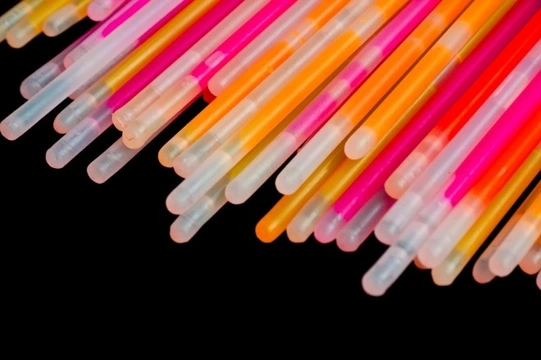
Glow sticks - A potential hazard to your dog
Glow sticks are inexpensive, readily available articles of costume jewellery or decoration, which consist of a flexible plastic tube filled with a chemical called dibutyl phthalate, which causes the stick to glow when activated. They can be purchased as items such as bracelets and necklets, as well as in the form of basic sticks to decorate the home or carry around, and are popular at parties, and with children and adults of all ages.
While glow sticks are very easy to buy with no age restrictions, and are usually safe for children of all ages when used in accordance with the directions, the chemical inside of the glow sticks, dibutyl phthalate, is actually a taste toxin, which can cause a pronounced reaction in both dogs and people if ingested. This rarely poses a problem for people, who are not apt to chew at their jewellery, but if your dog gets hold of a glow stick and pierces the casing, they may potentially be at risk of an adverse reaction.
In this article, we will look at what happens if your dog ingests some of the glow stick chemical, what can be done about it, and how to prevent a problem from arising. Read on to learn more.
What happens when dibutyl phthalate is ingested?
The chemical in glow sticks, dibutyl phthalate, is extremely unpalatable to both dogs and people, which discourages full ingestion in the vast majority of cases. Biting into or tasting some of the chemical generates what is known as an intense taste reaction, which will usually be immediately apparent. The first sign you should look out for is a punctured or chewed glow stick, or the presence of the illuminated chemical on your dog or around the home. The symptoms your dog will display after tasting the chemical will generally include all of the signs of having tasted something incredibly foul, potentially including:
- Excessive drooling.
- Foaming at the mouth.
- Pawing or scratching at the mouth.
- Head shaking.
- Yelping or verbalisations of distress.
- Extreme agitation, which may manifest as aggression in some cases.
- Occasionally, vomiting or retching.
All of these symptoms are related to the adverse taste reaction that comes from biting a glow stick, and this reaction in and of itself is the issue, and the material itself is not generally poisonous internally. However, it should not be understated how extreme the taste reaction that the chemical produces itself can be.
What to do if your dog ingests dibutyl phthalate
You will usually realise fairly quickly if your dog ingests some of the contents of a glow stick, and you should contact your vet for advice on how to proceed. As dibutyl phthalate does not produce systemic poisoning, while your vet may tell you to bring your dog into the clinic for care and monitoring, in many cases, you will be advised to simply manage the reaction and monitor your dog at home.
If you do go along to the clinic, your vet will examine your dog, look at their clinical history, and consider if there are any other factors relating to their health or general wellness that may exacerbate their reaction.
Management of ingestion is usually limited to providing plenty of water, and possibly milk or some wet food, so that your dog can remove the taste of the substance from their mouth. You should of course also clear up any of the spilled substance, and ensure that it is removed from your dog’s fur to prevent later ingestion.
Turning off the lights and darkening the room can help you to see where the glowing contents of the sticks have ended up! You will possibly need to thoroughly bathe your dog to remove the last traces of the chemical if they have got into a real mess.
Preventing glow stick ingestion
The best way of avoiding a drama that can soon put an end to your party or other festivities is to ensure that your dog and glow sticks are kept well apart! Always store glow sticks out of the reach of your dog, and ensure that any guests or children that you have over know not to use a glow stick as a toy, or encourage your dog to play with one.
Some people put glow stick collars on their dogs for fun, or even to help to make them more visible in the dark when out on walks; this can be fine, but you do need to keep an eye on your dog while they are wearing the collar, and do not leave them unsupervised in it. If your dog tries to chew at it or otherwise interfere with it, remove it promptly before a problem has the chance to develop!
It is also worth noting that glow stick chemical ingestion can affect cats in much the same way as it can dogs, however, cats are exponentially less likely to chew or otherwise pierce a glow stick in the first place.



